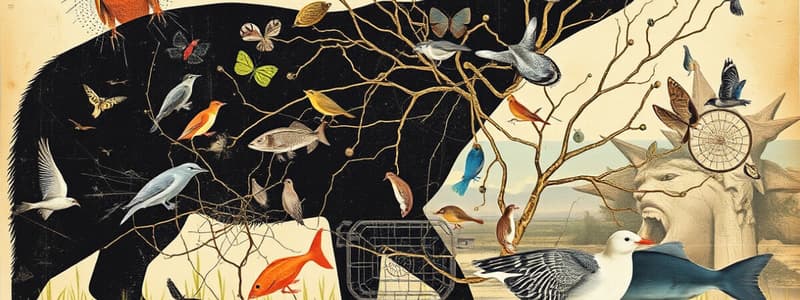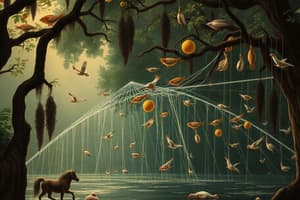Podcast
Questions and Answers
What happens to a prey population if a predator becomes extinct?
What happens to a prey population if a predator becomes extinct?
- The prey population decreases significantly.
- The prey population can reproduce more. (correct)
- The predator finds a new food source.
- The ecosystem remains unchanged.
What is a major consequence of introducing non-native species like rabbits to a new environment?
What is a major consequence of introducing non-native species like rabbits to a new environment?
- They coexist peacefully with native species.
- They sustain biodiversity.
- They often cause damage to existing food webs. (correct)
- They support local ecosystems.
How does plastic affect marine life according to the information provided?
How does plastic affect marine life according to the information provided?
- Plastic is used by fish for building nests.
- Marine animals mistake plastic for food. (correct)
- Plastic provides shelter for sea creatures.
- Plastic helps filter ocean water.
Why is plastic considered a serious concern in food chains?
Why is plastic considered a serious concern in food chains?
What happens to plastic over time after it is thrown away?
What happens to plastic over time after it is thrown away?
What do microplastics accumulate in the bodies of fish?
What do microplastics accumulate in the bodies of fish?
How might microplastics impact the gills of fish?
How might microplastics impact the gills of fish?
What is a consequence of larger predators consuming plastic?
What is a consequence of larger predators consuming plastic?
What role does the presence of microplastics play in our food supply?
What role does the presence of microplastics play in our food supply?
Why are food webs considered delicately balanced?
Why are food webs considered delicately balanced?
Flashcards are hidden until you start studying
Study Notes
Food Web Balance
- Food webs rely on a delicate balance; disruption can lead to extinction and habitat loss.
- Extinction of predators allows prey populations to grow unchecked, risking overpopulation and subsequent over-hunting.
Impact of Introduced Species
- Rabbits were introduced to Australia in 1859, spreading rapidly within 50 years.
- Their population explosion has caused significant damage to local food webs and ecosystems, rendering them a pest.
Human Impact on Food Chains
- Human activities often lead to harmful substances entering food chains, disturbing natural balances.
- Plastic pollution is a primary concern due to its widespread environmental effects, particularly in oceans.
Plastic Breakdown and Microplastics
- Plastic is non-biodegradable and accumulates in landfills, eventually breaking down into microplastics.
- Microplastics are defined as particles smaller than 5mm and can accumulate harmful pollutants in their structure.
Effects on Marine Life
- Fish mistakenly consume microplastics, leading to toxins entering the food chain.
- The gills of fish can absorb microplastics, potentially affecting their respiratory health and overall wellbeing.
Consequences for Human Consumption
- Many fish species consumed by humans are now contaminated with microplastics due to their presence in the oceans.
Key Insights
- Understanding food web dynamics is essential for ecological conservation.
- Awareness of how human activities, especially plastic use and waste, impact ecosystems can guide more sustainable practices.
Studying That Suits You
Use AI to generate personalized quizzes and flashcards to suit your learning preferences.




